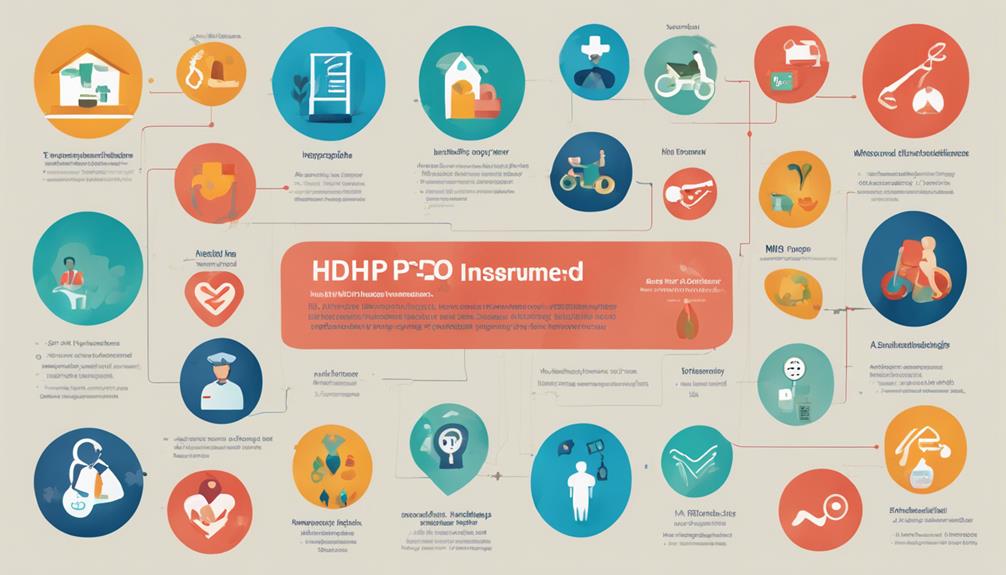Choosing health insurance involves several key factors. Start by evaluating your health needs, including any chronic conditions and how often you seek care. Next, compare plan types like HMOs, which have restrictive networks, to PPOs that offer more flexibility at a higher cost. Review premiums alongside out-of-pocket expenses to gauge total potential costs. Also, examine network provider options and policy exclusions to avoid unexpected surprises. Understanding these elements will guide you towards a plan that best fits your lifestyle and budget. There's more to reflect on, so exploring additional details can enhance your decision-making.
Understanding Health Insurance Types

When selecting a health insurance plan, it's crucial to understand the various types available, as each offers different coverage options and cost implications. Major categories include Health Maintenance Organizations (HMOs), Preferred Provider Organizations (PPOs), and High Deductible Health Plans (HDHPs). Each type has unique structures that can affect your out-of-pocket costs and the flexibility of your healthcare choices.Who Health Workforce
For instance, HMOs often require you to choose a primary care physician and obtain referrals for specialists. This can streamline premium calculations but may limit your options. Conversely, PPOs provide greater flexibility in choosing healthcare providers without requiring referrals, but their premiums might be higher.
You should also pay attention to policy exclusions in each plan, as these can notably impact your financial liability. Common exclusions might include specific treatments, pre-existing conditions, or certain types of medications.
Evaluating Your Health Needs
Evaluating your health needs involves a thorough assessment of your current medical situation, potential future health concerns, and the frequency of healthcare services you typically require.
Start by reviewing your personal health history. Consider any chronic conditions, past surgeries, or ongoing treatments that could affect your insurance requirements. This will help you identify the specific coverage you need, such as specialist visits or prescription medications.
Next, reflect on your lifestyle factors. If you lead a physically active life or have a high-stress job, you may need more extensive coverage for preventive care or urgent medical services. Conversely, if you're generally healthy and engage in low-risk activities, a basic plan may suffice.
Don't forget to think about your family's health history. Genetic predispositions to certain illnesses can influence the types of services you might need in the future.
Comparing Costs and Premiums

Comparing costs and premiums is essential for finding a health insurance plan that fits your budget while still meeting your healthcare needs. Start by reviewing premium comparisons across various plans. Premiums, the monthly payments you make, can vary greatly, so identifying what you can afford is critical.
Next, consider cost sharing strategies, which determine how much you'll pay for services after meeting your deductible. Look at co-pays, coinsurance, and out-of-pocket maximums. These elements can impact your overall healthcare spending, making it important to analyze them alongside premiums.
When comparing plans, don't just focus on the monthly premium; calculate your potential total costs based on your expected healthcare usage. For example, if you anticipate frequent medical visits, a plan with a higher premium and lower out-of-pocket costs might be more economical in the long run.
Ultimately, understanding both the premiums and the cost sharing strategies will help you make a more informed decision. By weighing these factors carefully, you can select a health insurance plan that aligns with your financial situation while ensuring you receive the necessary care.
Assessing Coverage Options
When evaluating coverage options, you need to understand the various types of coverage plans available and how they align with your healthcare needs.
Key policy features, such as deductibles, copayments, and out-of-pocket maximums, greatly impact your overall experience and costs.
Types of Coverage Plans
Understanding the different types of coverage plans available is essential for making an informed decision about your health insurance options. You'll typically encounter two main categories: government programs and private plans.
Government programs, such as Medicare and Medicaid, provide specific benefits tailored to certain populations, including the elderly and low-income individuals. These programs often have standardized coverage and may require minimal out-of-pocket expenses, but they also come with eligibility criteria that you must meet.
On the other hand, private plans offer a wider variety of choices, including Health Maintenance Organizations (HMOs), Preferred Provider Organizations (PPOs), and Exclusive Provider Organizations (EPOs). Each of these plans has unique features regarding provider networks, cost-sharing, and flexibility in accessing healthcare services. While private plans may offer more customization, they often come with higher premiums and varying out-of-pocket costs.
When evaluating your options, consider your healthcare needs, financial situation, and personal preferences. Weigh the benefits of government programs against the flexibility of private plans to determine which type of coverage aligns best with your lifestyle and health requirements.
Key Policy Features
Evaluating key policy features can greatly impact your decision as you consider the various coverage options available within both government programs and private plans. One vital aspect to assess is policy exclusions. These exclusions specify what services or treatments aren't covered, which can greatly affect your access to necessary healthcare. For instance, if you have a pre-existing condition, knowing whether it's excluded from coverage is critical to avoid unexpected costs.
Another important feature to examine is benefit limits. These limits define the maximum amount your insurance will pay for specific services or over a certain period. If you require extensive medical treatment, understanding these limits can help you gauge potential out-of-pocket expenses.
Additionally, you should evaluate the overall benefits package, including preventive services, hospitalization, and prescription drug coverage. This thorough view allows you to compare options more effectively.
Ultimately, by carefully analyzing policy exclusions and benefit limits, you can make a more informed decision that aligns with your healthcare needs and financial situation. Prioritize these features during your selection process to guarantee complete coverage that meets your expectations.
Network of Providers

A health insurance plan's network of providers greatly influences your access to quality care and the overall cost of your healthcare services. When evaluating plans, consider the provider availability within the network. A broad network allows you to choose from various doctors, specialists, and hospitals without facing exorbitant out-of-pocket costs. Conversely, a narrow network may limit your options, forcing you to seek care from a select group of providers.
Network restrictions are critical to understand. Some plans require you to select a primary care physician (PCP) or obtain referrals for specialist visits. If you prefer flexibility, look for plans with fewer restrictions, as these often provide greater access to needed services. However, keep in mind that plans with extensive networks may come with higher premiums.
Ultimately, you'll want to balance provider availability with your budget. Review the list of in-network providers and verify that your preferred doctors are included. By taking these factors into account, you'll make a more informed decision about which health insurance plan aligns with your healthcare needs and financial situation.
Reviewing Plan Benefits
When reviewing plan benefits, it's vital to pinpoint what services are covered and how they align with your healthcare needs. Start by closely examining the summary of benefits provided by the insurance plan. This document outlines important services like primary care visits, specialists, hospitalization, and preventive care.
Be sure to identify any plan limitations, as these can greatly affect your access to necessary treatments. Limitations might include the number of visits allowed per year or caps on reimbursement for specific services. Understanding these boundaries helps you gauge whether the plan meets your healthcare expectations.
Also, pay attention to benefit exclusions—services that the plan won't cover at all. Common exclusions may include cosmetic procedures, experimental treatments, or certain types of therapy. Knowing these can prevent unpleasant surprises when you seek care.
Ultimately, evaluating both the covered services and the limitations or exclusions is vital for making an informed decision. By aligning your healthcare needs with the plan's offerings, you can guarantee you're choosing a policy that provides the coverage necessary for your well-being.
Enrollment and Timing Considerations

Understanding the benefits of a health insurance plan is only part of the equation; knowing when and how to enroll is equally important to guarantee you secure the coverage you need. Open enrollment periods are your primary opportunity to enroll in or switch health insurance plans. Typically occurring once a year, these windows last for several weeks, allowing you to review options, compare plans, and make informed decisions.
It's essential to mark your calendar for these dates, as missing the open enrollment period can limit your coverage choices. If you find yourself needing insurance outside of this timeframe, you may qualify for a special enrollment period. These circumstances—such as marriage, having a baby, or loss of other coverage—allow you to enroll or change your plan outside the standard open enrollment.
To navigate this process effectively, stay informed about the specific dates and criteria for both open and special enrollment periods. By doing so, you'll guarantee that you don't miss critical opportunities to obtain the health insurance that best meets your needs.
Being proactive in your enrollment strategy can greatly impact your overall health and financial security.
Conclusion
Choosing the right health insurance requires careful consideration of your specific needs and circumstances.
By understanding the various types of plans, evaluating your health requirements, and comparing costs, you can make an informed decision.
Don't overlook the importance of coverage options, provider networks, and plan benefits.
Timing is essential, too, so make sure you enroll when the opportunity arises.
Ultimately, taking these steps will help you secure a health insurance plan that best fits your lifestyle and budget.
